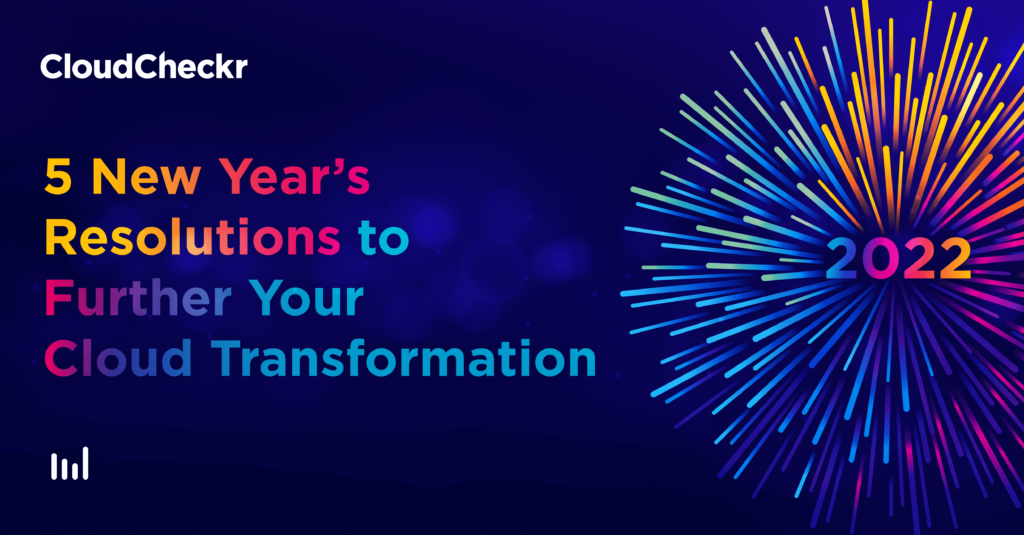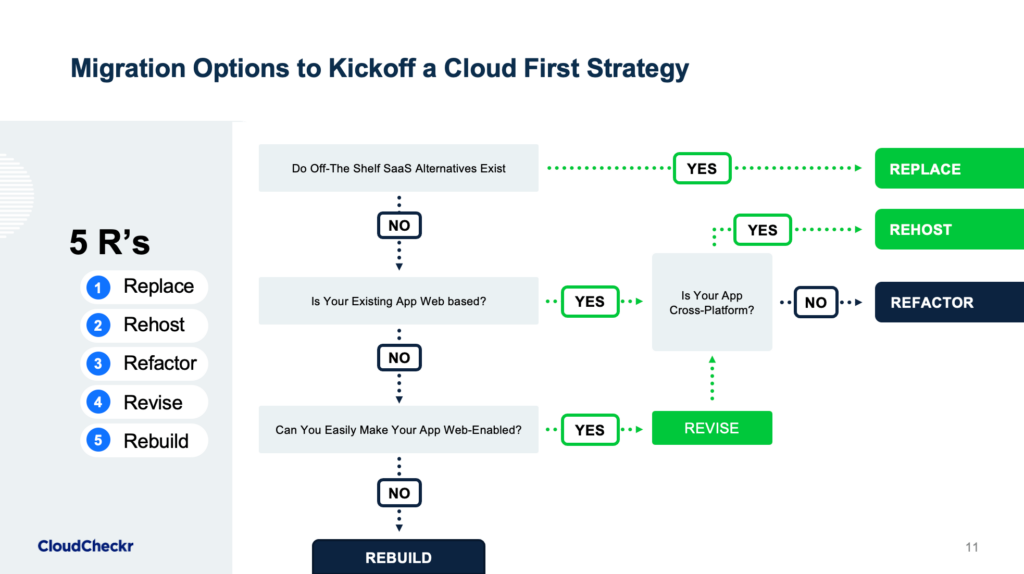Has the uncertainty of the past couple of years pushed aside your plans for cloud transformation? If so, you’re not alone. According to our 2021 Cloud Infrastructure Report, 93% of respondents faced budget challenges going into this year, and 55% had no baseline for planning after the pivots they made in 2020.
However, many organizations aren’t letting those obstacles stand in their way. Estimated cloud spend in 2022 is expected to exceed $482 billion worldwide, according to Gartner. Gartner also named several key trends in cloud computing, with the top being cloud ubiquity, or the increased need for organizations to adopt the cloud and related services. Therefore, cloud computing will only become more in-demand for organizations in the coming years.
In other words, you can’t avoid cloud transformation forever. With next year on the horizon, you have the opportunity to plan ahead for the next year and beyond with a fresh cloud-first strategy.
CloudCheckr hosted a webinar with CloudHesive, an Amazon Premier Partner and Amazon Managed Services Partner, to share tips for developing a cloud-first strategy for the new year.
For maximum impact, we recommend watching the free webinar on-demand to begin planning your New Year’s (cloud) resolutions. Reading this at the end of year or the start of the new one? Your timing is great. Right now, you have the opportunity to set these five cloud transformation resolutions for the new year.

Resolution 1: Maximize this year’s budget for a clean slate in the new year
If you have a “use-it-or-lose-it” fiscal year budget, then you already know you need to spend money now or risk seeing decreased future funding. If you’re facing a surplus at the moment, there are ways to take advantage of your end-of-the-year funds. One way is to prepay for next year’s cloud capacity with committed use discounts.
In AWS, for example, these discounts include paying for Reserved Instances and Savings Plans. For these, you can choose either one- or three-year terms. Prepaying for cloud computing can help you make smart decisions for next year’s budget and take advantage of lower costs right now. In general, Reserved Instances can provide a discount of up to 72% when compared with on-demand EC2 instance pricing.
Todd Bernhard, Director of Product Marketing at CloudCheckr, gave an example in our webinar of prepay versus pay-as-you-go cloud costs. You might spend more up front at the end of the year, but this greatly reduces the need for on-demand resources. This, in turn, helps reduce spiking costs from month-to-month and makes it easier to predict monthly cloud spend. In Todd’s example, you might prepay $1,700 for $3,300 of computing power.
Resolution 2: Kick off new projects with a cloud-first strategy
Going “cloud-first” means that you always have the computing capacity you need on any given day. This strategy helps businesses reduce wasteful spending and intelligently plan for expansion with their existing cloud resources.
Operating in the cloud differs from running a data center in that with cloud, you don’t have to always have resources commissioned at full capacity. In other words, if you’re an online retailer, you want to plan for spikes in traffic with those Black Friday and Cyber Monday sales. Running a data center means that you need to have the servers on hand to handle that capacity at all times, even though you might not need that computing power every single day.
With the variable spend model of the cloud, you have the exact capacity you need on a daily basis. If there is a spike in traffic, such as during a Cyber Monday sale, you can scale instantly to meet that demand.
To kick off a cloud-first strategy, consider Gartner’s 5 R’s of migrating to the cloud. Which steps do you need to complete in order to see the most success in your cloud investment?
Replace
This is an easy solution, meaning that if an off-the-shelf Software-as-a-Service (SaaS) offering exists, you can choose one of these options to do the job for you at little to no expense.
Rehost
Rehosting is a lift-and-shift to the cloud. This can also be accomplished easily, so long as your web-based app is already set up to run on a cloud platform using web standards such as Linux, PHP, JavaScript, or others.
Refactor
You might refactor a service if the code doesn’t support that migration. This means changes to code or switching to a solution that supports cross-platform use.
Revise
Revising includes modifying existing code, an important part of legacy modernization. The Revising step will also include rehosting and refactoring in order to make the app web-enabled.
Rebuild
The final option is to rebuild by architecting new workloads using cloud-specific technologies and concepts, such as Edge computing, NoSQL databases, microservices, serverless, IAM and more. This method may involve more commitment from your team, but in the end you will see the greatest efficiencies with this process.

You may need to do some or all of these steps, depending on which applications, services, and workloads you want to replicate or establish in the cloud. Use the diagram above (from the webinar) or watch the complete presentation to get more insight into the 5 R’s of cloud migration.
Resolution 3: Source new talent and train current employees
Let’s talk about the elephant in the room: “The Great Resignation.” One of the ways to avoid seeing qualified employees walk out the door is to ensure that they have the resources they need to do their jobs well.
What if you train people and they leave? This is a common fear for employers as they weigh the costs and benefits of continued employee education. But there’s a better question to ask in this situation, with far more dire consequences: What if you don’t train them, and they stay?
Training employees makes them more empowered and efficient. Yes, someday they might go somewhere else, and you’ll have to compete to keep them on your team. But when you give your staff advancement opportunities and training, they can feel that they make a valuable contribution to the organization. That effort can go a long way in retaining your best workers.
Conversely, if you try to save money by not investing in training, all you end up with is an untrained staff. In fact, not training your employees could cost you more. In a report from Skillsoft, two-thirds of employers surveyed estimate that lack of on-the-job skills results in between three and nine hours per week of lost productivity for an IT professional. An additional 12% of decision-makers say that untrained employees lose as much as 10 hours of productivity per week. That adds up to 520 hours per year, and a cost, on average of about $29,000, according to Skillsoft. In short, it’s costing you more to not train your employees.
And what about attracting new employees, you might ask? By offering on-the-job training and opportunities for advancement, you can improve recruitment efforts and better retain these new additions to your team.
Resolution 4: Implement new tech like serverless, microservices, and containers
You never want to adopt new technology just for new technology’s sake. But today, there are many innovations on the market that can help you save time and/or money and meet other objectives that you set for 2022. Some examples that we highlighted in the webinar include:
Microservices
Our cloud management platform, CloudCheckr CMx, is a microservices-based technology. It means that we can launch new features within the platform without having to change the overall monolithic code of the platform. Using microservices has enabled us to release additional cost, security, and resource management capabilities to our customers faster than before, including our newly released Well-Architected Readiness Advisor.
Serverless
Serverless architecture enables you to build and run servers without having to manage their infrastructure. An additional benefit of serverless is that once the project concludes and you no longer need to run these resources, you don’t have to keep paying for them.
Containers/Kubernetes
Containers allow you to compartmentalize your applications and run them easily on public cloud or on-premises. You might also choose to use Kubernetes, also known as K8s, which is an open-source system that automates deployment, scaling, and management of containerized applications.
Multi-Factor Authentication
By requiring both a password and an additional code sent via text, email, or to a keyfob, organizations can promote better cybersecurity practices. This means that even if passwords are compromised, there is an additional line of defense between hackers and your IT resources.
Virtual Desktops
With the recent release of Windows 11, IT administrators would have their work cut out for them if they had to update all operating systems within an enterprise. The quickest way to enable employees to take advantage of new features is to enable them through a Virtual Desktop. In this case, the IT personnel can update the OS on a server and give everyone remote access to that new OS through Virtual Desktop.
Resolution 5: Leverage the resources you already have at your disposal
Finally, remember not to discredit the resources you already have on your side. One way to do so is to look to your vendors for help.
Managed service providers (MSPs) are there to help you succeed in the cloud. For example, if you’re looking into the differences between Amazon Workspaces (Platform-as-a-Service) and Amazon AppStream 2.0 (SaaS), your MSP can help you decide which will work for your business needs — and your budget. Jamie Marshall, Vice President of Cloud Services at CloudHesive, gives a breakdown of these options in our webinar, as well as insights into other common challenges related to cloud initiatives.
Using technology, like a cloud management platform? This gives you the advantage of increased visibility as you plan cost management, security, and cloud resource initiatives for the new year.
As the new year approaches, reach out to your technical account reps and managed services teams to get their expertise. They’ll be glad to help, and you’ll have a more well-rounded approach to your cloud transformation projects.
New Year, New Opportunities for Cloud Transformation
There’s no time like the present. Any time is the right time to begin planning. The good news is that if you’re already thinking about the cloud, you’ve achieved the first step in the process.
Watch the on-demand webinar to learn how to make your cloud transformation a success in the new year.
Cloud Resources Delivered
Get free cloud resources delivered to your inbox. Sign up for our newsletter.
Cloud Resources Delivered
Subscribe to our newsletter
